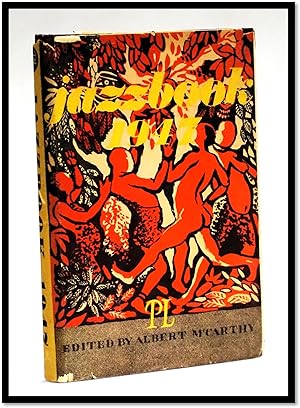mccarthy albert contributions zora neale (1 resultados)
Tipo de artículo
- Todos los tipos de productos
- Libros (1)
- Revistas y publicaciones
- Cómics
- Partituras
- Arte, grabados y pósters
- Fotografías
- Mapas
- Manuscritos y coleccionismo de papel
Condición
Encuadernación
- Todas
- Tapa dura (1)
- Tapa blanda
Más atributos
- Primera edición
- Firmado
- Sobrecubierta (1)
- Con imágenes (1)
- No impresión bajo demanda (1)
Gastos de envío gratis
- Gastos de Envío Gratis a EEUU
Ubicación del vendedor
Valoración de los vendedores
-
Jazzbook 1947
Publicado por PL Editions Poetry, London, 1947
Librería: Blind-Horse-Books (ABAA- FABA), DeLand, FL, Estados Unidos de America
Hardcover with Dust Jacket. Condición: Near Fine. Estado de la sobrecubierta: Very Good. First Edition, First Printing. Dark wine-red cloth with green spine titles; 7.5 inches tall; 171 pages; Profusely illustrated with black and white photographs, including frontispiece of Louis Armstrong. The bindings are tight and square. Text clean, light even toning. Minimal shelf handling wear. Colorful dust jacket is unclipped with even age-toning and tiny loss on the spine tips. With laid-in publisher's ticket indicating a review copy. A fascinating period study of the world of jazz in the 1940s, this inaugural edition of yearly anthologies featuring articles by English and American writers on jazz seeks to establish valid criteria for appreciating the art form for the first time. Additionally, it offers critiques of individual players, aiming to provide comprehensive insights into the genre. historical pieces which trace the origins of swing from the negro workers' songs and the brass bands and small orchestras which played in the streets, the bars and the sporting houses of New Orleans, that "wide-open town" of the Nineties. An interesting feature is the section in which famous jazz musicians, among them Louis Armstrong, write about their early experiences. Historical articles within the anthology delve into the roots of swing, tracing its origins from the songs of African American laborers to the brass bands and small orchestras that frequented the streets, bars, and sporting houses of New Orleans during the vibrant era of the 1890s. Of particular note is a captivating section where renowned jazz musicians, including Louis Armstrong, share their personal accounts of their formative years in the jazz scene.


